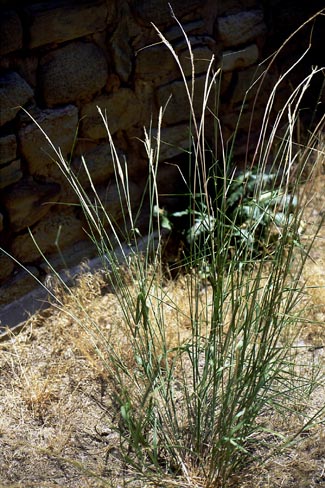Sand Dropseed

Common Name(s):
Sand Dropseed
Scientific Name:
Sporobolus cryptandrus (Torr.) Gray
Scientific Name Synonyms:
None known
Symbol:
SPCR
Description:
Life Span: Perennial
Origin: Native
Season: Warm
Growth Characteristics: A perennial bunchgrass, without rhizomes, growing 1 to 2 ½ feet tall in small tufts; erect to spreading or decumbent at base. It starts growth in the early spring, and seeds mature June to August. It produces an abundance of seeds, and reproduces readily from seeds and tillers.
Seedhead: Open panicle, up to 10 inches long, often reddish or lead-colored at flowering, often partly or entirely enclosed in the uppermost leaf sheath; spikelets very small contain 1 floret; seed shatters from lemma and palea, hence the name "dropseed."
Leaves: Blades glabrous, short (4 to 8 inches), flat and moderately wide at base but rolled toward the pointed tips, become frayed or "flagged" at maturity by the wind; sheaths fringed on margins, most prominently on overlapping margins, otherwise glabrous; conspicuous tuft of stiff, white hairs around collar; ligules comprised of fringe of short hairs; auricles absent.
Ecological Adaptions:
Sand dropseed is native to many of the low elevation and low rainfall rangelands of Utah. It occurs on several upland and semi-desert sites, with precipitation between 5 to 15 inches annually.
Soils: It commonly grows on sandy soils but is adapted to medium textured soils also. It is found also, but to a lesser extent, on gravelly, stony, and cobbly sandy loams. Sand dropseed is not tolerant of wet soils.
Associated Species: Big sagebrush, saltbush, western wheatgrass, Indian ricegrass, and sand sagebrush.
Uses and Management:
Being a warm-season grass, sand dropseed is better suited for summer grazing than for spring range. It provides fair to good forage for cattle, sheep and horses. It is also used to some extent by antelope, deer, small mammals, and upland game birds. The forage value declines rapidly with maturity. Sand dropseed will increase with excessive grazing or after drought, but is susceptible to severe drought.
Sand dropseed is a very essential grass for wind erosion control on sandy soil sites. It inhibits water pollution by reducing the blowing of sand into stream channels.
New seedlings of sand dropseed should not be grazed for 2 or 3 growing seasons depending on climatic conditions, especially the amount of moisture. After plant establishment, it will tolerate harvest of about 50 percent of the annual growth.

